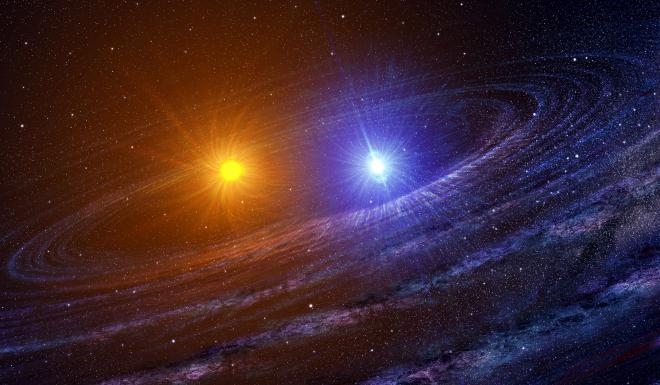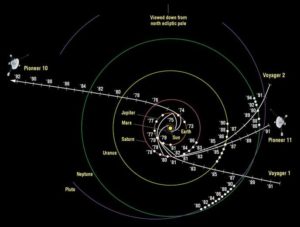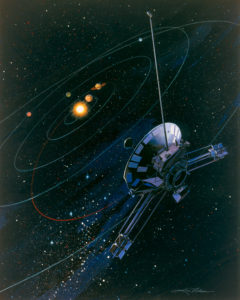by Dr. Alec MacAndrew and David Palm
The observation of aberration of starlight is a powerful piece of evidence in favor of the motion of the Earth. It represents objective evidence that the geocentrists are wrong. Aberration admits of a perfectly reasonable and straightforward explanation – it is caused by the motion of the Earth around the Sun according to the universally observed laws of gravity. On the other hand, the neo-geocentric “explanation” for how aberration occurs with a motionless Earth fails utterly, revealing both their fundamental misunderstanding of the phenomenon and their inability yet again to explain even the most basic observable phenomena from within their own system. This article will explain why stellar aberration is such good evidence for the Earth’s orbital motion and why the neo-geocentric explanation fails.
What is Stellar Aberration?

James Bradley was the first to observe aberration of starlight in 1727 while searching for stellar parallax. Parallax is “a displacement or difference in the apparent position of an object viewed along two different lines of sight”. Once the Earth was understood to orbit the Sun, astronomers predicted that they should be able to observe parallax when viewing a star first from one side of the Earth’s orbit around the Sun and then again six months later when it is at the opposite side of its annual orbit (here’s a good video describing and illustrating this: link). Bradley’s instruments were not sensitive enough to detect the stellar parallax of even the nearest stars, but were sensitive enough to measure stellar aberration which is a bigger effect than parallax. Sure enough, once their instruments became sufficiently sensitive, astronomers were indeed able to observe stellar parallax, starting with Friederich Bessel’s successful measurement of the parallax of 61 Cygni in 1838, over 100 years after the first observation of stellar aberration. Since then both ground-based and space-based instruments have yielded ever more accurate parallax readings for more than one hundred thousand stars , out to a distance of around 3,000 light years. In future, ESA’s Gaia mission will measure the distance via parallax of up to a billion stars out to a distance of about 300,000 light years.

EAAE Astronomy
Stellar parallax itself provides powerful evidence for the motion of the Earth. Classical geocentrism would never predict its existence – simply put, it should not exist in an Earth-centered (geocentric) model in which the universe revolves around a motionless Earth at its center. As we will see, the neo-geocentrists’ “explanation” of stellar parallax ironically forces them to center the entire universe not on the Earth but on the Sun and then have the whole universe revolve around the Sun , while the Sun itself revolves around the Earth. Needless to say there is no known physics to explain this ad hoc and post hoc example of special pleading.
Bradley at first thought he was observing stellar parallax but it soon became clear that he was observing something else – it turned out to be stellar aberration. So let’s describe that related phenomenon, the aberration of starlight. Over a period of a year the apparent direction of all stars and galaxies appears to change by a small amount in a way that also depends on their location with respect to the ecliptic (the plane of Earth’s orbit around the Sun). The general form of the apparent figure traced out by the stars over a year is an ellipse. The major axis of the ellipse is about 41 arcseconds aligned with the ecliptic, and the minor axis varies from zero for stars on the ecliptic plane (so they trace out a straight line forwards and backwards) to the same 41 arcseconds for stars on the ecliptic pole (so they trace out a circle.)[1] (See this video [link] for a good presentation on aberration.)
The classical explanation for aberration is that the observed direction of incidence of light from the stars is given by the sum of two vectors – the velocity of light and the velocity of the Earth. In fact, in Bradley’s time, the speed of Earth’s orbit was known from Kepler’s and Newton’s laws, so the observed ±20.5 arcsecond amplitude of aberration was used to calculate the speed of light, a calculation which yielded a result very close to the currently accepted speed of light. This is direct physical evidence that the Earth is indeed in a gravitational orbit around the Sun. The modern explanation for stellar aberration, based on special relativity, uses the Lorentz transform to transform between the different inertial frames occupied instantaneously by the Earth as it orbits the Sun, and for an orbital speed much less than the speed of light, gives an aberration angle almost identical to the classical explanation.[2]
How Do Parallax and Aberration Differ?
Both stellar parallax and annual stellar aberration are similar annual phenomena, so how does stellar aberration compare with and differ from parallax? It is different in three important respects:
- The amplitude of stellar aberration is the same for all stars and galaxies, while the amplitude of parallax depends on the distance of the star.
- The amplitude of aberration is much bigger than parallax – the parallax of the closest star, Proxima Centauri, is about 26 times less than stellar aberration, and the parallax of stars gets proportionately less the further away they are.
- Parallax and aberration are 90 degrees out of phase, since parallax is proportional to the position of the Earth while aberration is proportional to its velocity. So, for example, if we observe a star lying on the ecliptic at zero degrees ecliptic longitude, for which the maximum parallax displacement occurs at the summer and winter solstices, then for that same star the maximum stellar aberration occurs at the vernal and autumnal equinoxes.
Here is the key point: If the Earth were stationary or moving at a constant velocity (that is, in an inertial frame), we’d never be able to observe stellar aberration. We only observe it because the Earth’s velocity vector is continually changing as it orbits the Sun, and this causes the angle of observed aberration (the observed direction of the star) to change over the course of the year. It’s difficult to understand how anyone who understands the history and the science can claim that stellar aberration is evidence for a stationary Earth. Let’s see why that is.
Reason #1: Annual stellar aberration exactly matches the diameter and period of the Earth’s revolution round the Sun, calculated from different and independent considerations such as orbital mechanics and the circumference and period of Earth’s orbit.
Reason #2: Stellar aberration is the same amplitude for all stars and galaxies independent of their distance.
Reason #3: Stellar aberration is caused by the component of the velocity of the observer perpendicular to the direction of the light rays from the star, and is completely independent of the velocity of the star itself (that’s why it’s 90 degrees out of phase with parallax – parallax is caused by the earth’s displacement, and aberration is caused by the Earth’s velocity). So stellar aberration must be caused by the velocity of the Earth changing with time and cannot be caused by motion of the stars a) because its magnitude is independent of the star’s distance and b) because stellar aberration is independent of motion of the source.

NESI
Reason #4: We test b) in Reason #3 empirically by observing rapidly orbiting binary stars . If aberration is caused by the velocity of the source, then the very high velocity of orbiting binary stars would cause an aberration in their observed position, and because the direction of their velocity is rapidly changing as they orbit, we would observe a change in the direction of the aberration. The consequence of this is that the observed separation of orbiting binaries would appear to be larger than they are and from what we observe – they would appear to be separated much further apart. That is not what we observe, hence the simple and straightforward explanation is shown to be the correct one – aberration is caused by the motion of the observer, and in the case of Earth-based observers by the motion of the Earth.
[De Sitter’s careful observations of binary stars in the early twentieth century substantiated the view that aberration does not depend on the motion of the source: “In 1913, Willem de Sitter argued . . . a star in a double-star system would usually have an orbit that caused it to have alternating approach and recession velocities, and light emitted from different parts of the orbital path would then travel towards us at different speeds. . . . That is, Kepler’s laws of motion would apparently be violated for a distant observer. De Sitter made a study of double stars and found no cases where the stars’ computed orbits appeared non-Keplerian” (link; see also E. Eisner, “Aberration of Light from Binary Stars-a Paradox?“)
What do the new geocentrists say about aberration of starlight and why won’t their explanation work?
While the neo-geocentrists have tried to explain aberration within their own system, their explanation is wholly inadequate and fails to account for numerous details we have highlighted above. We’ve already noted that the standard neo-geocentric “explanation” for parallax is that the entire universe is actually centered on the Sun – an interesting feature of a supposedly geocentric universe. So, according to them, the whole universe is centered on the Sun, while the Sun itself revolves around the Earth – coincidentally at just the period of revolution that we would expect if the Earth happened to be revolving around the Sun according to the universal law of gravitation, like any other planet. Thus, in their system the parallax is caused by the stars all moving in circles of 150,000 km radius, with the circles lying in the same plane as the ecliptic – a motion that we describe as a “wobble” of the star-field.
This same Rube Goldberg lash-up of a universe is what Robert Sungenis attempts to use to explain aberration as well:

Wikipedia
The geocentric explanation for stellar aberration is very simple, and the simplicity speaks for itself. In reality, there is no aberration of star light. Rather, what appears as aberrated star light on Earth is caused by a movement of the whole star field around a fixed Earth. Essentially, the cause for stellar aberration is the same as stellar parallax – the stars are aligned with the sun and thus revolve with the sun around the Earth each year.
Consequently, stellar aberration is not caused by a bending of the star’s light, but by the revolution of all the stars around the Earth, which, depending on the latitude of the star with respect to the Earth’s equator, makes the starlight appear as a circular or elliptical annual motion on Earth. The star field rotates around the Earth on the north/south celestial pole, but the pole itself revolves with a 20.5 arc second radius. As viewed from Earth, the motion of the stars on or near the celestial pole will form a circle in the north, an ellipse at 45° latitude and a hyperbola at the equator (GWW1, 11th ed., p. 155.)
[See the neo-geocentric video seeking to demonstrate their explanation here: link ]
 This “explanation” may have the advantage of being “very simple”, but it also has the disadvantage of being very simply wrong. For starters, the quote above coupled with another a few pages earlier in GWW shows that Sungenis doesn’t understand the phenomenon that he is attempting to explain. Sungenis thinks that the eccentricity of the form of stellar aberration (varying between a circle at one extreme and a straight line at the other) depends on where on Earth the observation is made:
This “explanation” may have the advantage of being “very simple”, but it also has the disadvantage of being very simply wrong. For starters, the quote above coupled with another a few pages earlier in GWW shows that Sungenis doesn’t understand the phenomenon that he is attempting to explain. Sungenis thinks that the eccentricity of the form of stellar aberration (varying between a circle at one extreme and a straight line at the other) depends on where on Earth the observation is made:
If one observes the stars at a 45º celestial latitude, he will see each of the stars form ellipses over a year’s period. The eccentricity of the ellipse will increase the greater one’s distance from the North Pole. If one observes from the equatorial plane, one will see the stars form an acute hyperbola or even a horizontal line (GWW1, 11th ed., p. 150f.)
This is a grotesque misunderstanding of the phenomenon. In fact, the form of the aberration is a circle for stars at the ecliptic pole, a straight line for stars on the ecliptic plane and an ellipse for stars lying between, where the eccentricity of the ellipse depends on the latitude of the star in ecliptic co-ordinates. The form of the aberration is independent of where on Earth the observation is made – this is a fundamental blunder on Sungenis’s part. And where he gets the idea that any of these motions form a hyperbola is anyone’s guess – that’s wrong too. Yet again, Sungenis shows that he is abjectly ignorant of the very things he pontificates about (see many more examples documented in “Robert Sungenis: Incompetent in Physics”.)

SlideShare
Sungenis is also simply wrong in his explanation of stellar aberration as a movement of the whole star field around the Earth. Why? First, as we have already seen, aberration and parallax are two distinct phenomena. They can’t both be explained by a movement of the whole star field centered on the sun around the Earth. They are different phenomena with different amplitudes, 90 degrees out of phase. If one is prepared to ignore the violation of orbital mechanics and other fatal physical objections (see the paragraph below), one could explain parallax by a motion of the whole star field in a circle with a radius of 150,000 kilometers, because that would look the same as a fixed star field with Earth orbiting the sun (the angular parallax is inversely proportional to the star’s distance). But it doesn’t work for stellar aberration because the amplitude of the angular aberration is the same for all celestial objects whether they are 4.5 light-years or 4.5 billion light years away. To get a phenomenon where the angular aberration is the same for Proxima Centauri or a galaxy at 4.5 billion light years, the diameter of the wobble for Proxima Centauri would be 4.3 billion kilometers and for the galaxy at 4.5 billion light years it would be 4.3 billion billion kilometers. This explanation is nonsense.
Second, the neo-geocentric “explanation” of aberration doesn’t consider the light time issue, which is fatal to the geocentric “wobbly universe” explanation of both the parallax and the aberration. For any given direction, the parallax of all stars is in phase and the aberration of all stars is in phase (and 90 degrees different from each other) regardless of their distance, but celestial objects are at a complete range of distances and their light takes from 4.5 years to ten billion years to reach us. Their individual wobbles would have to be arranged in such an out-of-phase way as to arrive in phase at the Earth accounting for different light propagation times from these different distances – you wouldn’t observe what we do observe if the cause of aberration was the whole star field wobbling together.
Let’s stick with reasonable explanations.
Thus, the existing neo-geocentric explanation fails at the most fundamental levels. It cannot fully “explain” stellar parallax, and it certainly cannot explain parallax and aberration together with the same mechanism. No doubt they’ll now scurry to come up with something else. But that they are compelled to find some alternative, tortured explanation for something that already admits of a perfectly reasonable explanation highlights a broader point in this whole debate. Not all explanations are equally reasonable. It is not sufficient to have some explanation, any explanation to stay in the realm of the reasonable.
Both aberration of starlight and stellar parallax admit of a simple, reasonable explanation that fits all the observable evidence – the Earth is orbiting the Sun according to the well understood and universally observed laws of gravity. The angular amplitudes of both parallax and stellar aberration are perfectly consistent with the radius of the Earth’s orbit, and therefore both phenomena can be explained with a simple fact: the Earth orbits the Sun once a year with an orbital radius of 150,000 kilometers. And after that there is no need or even justification to search for any other explanation. As the great philosopher Thomas Aquinas has said, “If a thing can be done adequately by means of one, it is superfluous to do it by means of several; for we observe that nature does not employ two instruments where one suffices”. Ironically the neo-geocentrists repeatedly do the very thing they so often belittle real scientists for – clinging tenaciously to their personal view in spite of the evidence against it.
The Bottom Line:
The bottom line is that both stellar parallax and even more so aberration of starlight are powerful evidence in favor of the motion of the Earth. The geocentrists’ proffered explanation for aberration fails on multiple levels. This demonstrates yet again that these men are incompetent in scientific fundamentals and also that they have no good answers for very basic observations from within their own system. Strict Geocentrism is once more shown to be a dangerous pseudo-science, an elaborate exercise in special pleading and conspiracy mongering.
Appendix 1: Debunking Geocentric Challenges to the Mainstream Explanation of Aberration
Geocentrist claim #1:
Additionally, the sun and the planets will show the same aberration, approximately 20.5 arc seconds. The only body exempt is the Earth’s moon. So the natural question is: what is causing the light of these celestial bodies to create these shapes and why is the moon exempt? . . . Whatever the true state of affairs for the heliocentric side, the dual explanation from different “frames of reference” will lend itself to establishing the geocentric explanation, which will offer a more cogent reason why the sun takes part in annual aberration. Moreover, the heliocentric argument will show itself not to have an explanation for why the planets show aberration and why the moon does not (GWW1, 11th ed. pp 151 and 155).
In order to understand how aberration applies within the solar system, we need to understand in which frame the aberration is measured. In the case of extra-solar objects we know that their apparent position changes throughout the year, but with respect to what? Since angular aberration is the same for all stars regardless of their distance, their apparent positions relative to one another remain unchanged as a consequence of the phenomenon, unlike the case of parallax where the closer star appears to move with respect to the background of more distant stars. So, in the case of aberration, the apparent movement of the stars is with respect to ecliptic co-ordinates or ECI (Earth-Centered Inertial) coordinates – if you point your telescope in the direction of the ecliptic pole and keep it fixed in that direction you’ll see celestial bodies trace out a circle of ±20.5 arcsecond – this is the stellar aberration.
Once we consider the aberration of bodies within the solar system, we have to think hard about what frame we are basing your measurements on. For the Sun, the aberration, based on heliocentric ecliptic co-ordinates, is the familiar 20.5 arcseconds, but because it’s always in the same sense as the direction of Earth’s orbital velocity (always to the west in ecliptic longitude), there is no annual variation. Light-time correction for the Sun in ecliptic co-ordinates is zero because the Sun is at rest in these co-ordinates. Light time correction for the Sun’s position in ECI co-ordinates has the same value as aberration in heliocentric ecliptic co-ordinates, because it is based on the same ratio of Earth’s orbital speed to light speed.
The apparent direction of planets in heliocentric ecliptic co-ordinatesas observed from Earth is aberrated, and depending on the relative locations of Earth and planet, can have a periodic variation, but the co-ordinates of a planet change considerably during the course of an Earth year because of their own orbits. Planetary aberration is defined as the sum of the stellar aberration caused by the motion of the Earth in heliocentric ecliptic co-ordinates (just the same as annual stellar aberration) and the difference between the apparent and actual position of the planet caused by the motion of the planet during the time that light takes to travel from the planet to Earth. For planets within Earth’s orbit (Mercury and Venus) there is no periodic variation in stellar aberration. For the planets and other solar system bodies outside Earth’s orbit there are periodic variations in stellar aberration, with periods longer than one year. The period of the aberration for planets is their synodic period, which is the time between the closest approaches of the planet to the Earth). The synodic period for Mars is 780 days, for Jupiter it is 399 days, for Neptune it is 368 days. The further the planet is from the sun, the closer its synodic period approaches one Earth year.
Annual aberration is caused by Earth’s orbit around the Sun, or in relativistic terms by Earth’s change of reference frame as it orbits, but the moon and Earth are orbiting together around the Sun in the same frame, so that there is no aberration of moonlight.
Thus, the neo-geocentrists are simply wrong when they claim that “the heliocentric argument will show itself not to have an explanation for why the planets show aberration and why the moon does not.”
It’s worth remembering, too, that there is no such thing as absolute velocity in relativity, so stellar aberration can only be observed, and only has meaning where the observer is in a non-inertial frame – in other words is changing inertial frame over time. It is the orbit of the Earth and the fact that its velocity is changing annually as it orbits the Sun that enables us to observe stellar aberration.
Geocentrist claim #2:
There is one other factor to consider – the speed of light and the difference between the source and the receiver of the star light. Modern heliocentrism believes: (a) star light is independent from the star once it is emitted from the star, and (b) the emitted star light is not independent of the motion of the receiver. The geocentric explanation has incorporated both of these heliocentric parameters. In doing so, it has shown that whereas the heliocentric explanation requires the phenomenon to be an actual aberration of light, the geocentric explanation holds that it is caused by a vector radiation of light from the star that is not aberrated but travels in a linear direction to the viewer on Earth. In later chapters we will see how this result agrees in principle with the results of the experiments performed in 1871 by George Biddell Airy (GWW1, 11th ed. p. 158).
This geocentric “explanation” is essentially incoherent. As we have already demonstrated in the main body of this article, one cannot predict the observed aberration if one assumes that the phenomenon depends on motion of the source, and there is good reason to discount motion of the source as a cause. We don’t know what a “vector radiation” is, and there Sungenis offers no mathematical or even verbal explanation for how stellar aberration could arise if the Earth is stationary. Where in Sungenis’s book, Galileo Was Wrong, can we find the demonstration alluded to here?
Geocentrist claim #3:
Finally, in the geocentric model, the sun and planet’s 20.5″ movement is caused by their annual traveling with the rest of the star field and thus they will react in the same manner as the stars. The moon, however, does not show a 20.5″ movement since it is locked in place by the gravity of the fixed Earth. The heliocentric model has no explanation for these phenomena (GWW1, 11th ed., p. 158).
This is incorrect. As pointed out above, aberration is a consequence of motion of the observer, and cannot be explained by the motion of the entire universe with respect to the Earth for several reasons that we have explained above. In relativistic terms it is a consequence of the fact that the Earth is not at rest in an inertial frame.
However, the moon and Earth are orbiting together in a single frame (the Earth-moon barycenter), and the Earth remains in that frame throughout the year, so there is no annual aberration of moonlight. In ECI co-ordinates there is a light time correction of the moon’s position given by vm/c, where vm is the moon’s orbital speed. Vm = 1.02km/s, so vm/c = 3.42 x 10-6 radians or 0.704 arcseconds. So the fact is that there is a perfectly good real physics explanation for these phenomena, a monumentally superior explanation compared with the neo-geocentrists’ ridiculous “explanation”.
Fundamentally, claim #3 depends on the neo-geocentrists’ foundational claim that aberration can be explained by a “wobbly universe”, a claim which we have already demolished in the body of this article. It is even more obviously incorrect for solar system bodies, because the planets change their distance to Earth by significant amounts as they and the Earth orbit the Sun, so if the explanation of aberration is a wobble of the planets, Sun and stars round the Earth, a planet’s wobble would have to change its displacement amplitude in direct proportion to its distance from us to keep the angular aberration constant as observed. Again, the neo-geocentrists are forced to pile absurdity upon absurdity in order to explain a phenomenon that admits of a perfectly simple and reasonable explanation, namely, that the Earth is orbiting its star according to the universal laws of gravitation, just like any other planet.
End Notes:
[1] Because the instantaneous amplitude of the aberration is proportional to the instantaneous amplitude of Earth’s velocity (its speed), stars on the ecliptic axis don’t trace out an exact circle but a slightly misshapen circle caused by the eccentricity of Earth’s orbit. The speed of Earth’s orbit is maximum at perihelion and minimum at aphelion.)
[2] The classical vector sum of the two velocities, that of light and of the Earth at right angles to the light propagation direction, explained Bradley’s and later experiments very well. For example, for a star on the ecliptic pole, the angle of aberration, alpha, was predicted by the simple vector addition of the two velocities by tan(alpha) = v/c, where v is the speed of Earth’s orbit and c is the speed of light. So alpha = tan-1(2.98 x 104/2.99×108) = 20.56 arcseconds. The more rigorous relativistic prediction, based on the Lorentz transform, gives, for v<<c, sin(alpha) = v/c, so alpha = sin-1(2.98 x 104/2.99 x 108) = 20.56 arcseconds. So, the classical and relativistic calculations give the same result for the earth’s orbital velocity, but will diverge for higher velocities.
 Those who have not spent much time critically reading the works of Robert Sungenis on strict Geocentrism may be unaware of how often he resorts to debater’s tricks when responding to his opponents. One of his favorites is misdirection. In many instances he appears to give a fulsome answer, but a closer look shows that he’s failed to engage his opponent’s argument at all. His frequent modus operandi is to overwhelm the reader with copious but irrelevant verbiage, in the hopes that the reader will confuse quantity of words with intellectual substance.
Those who have not spent much time critically reading the works of Robert Sungenis on strict Geocentrism may be unaware of how often he resorts to debater’s tricks when responding to his opponents. One of his favorites is misdirection. In many instances he appears to give a fulsome answer, but a closer look shows that he’s failed to engage his opponent’s argument at all. His frequent modus operandi is to overwhelm the reader with copious but irrelevant verbiage, in the hopes that the reader will confuse quantity of words with intellectual substance. One example is in his non-answer to the challenge posed by Dr. Alec MacAndrew concerning the Pioneer 10 and 11 spacecraft. Dr. MacAndrew’s challenge is reproduced below from his article “Here Comes the Sun: How the new geocentrists persist in scientific and logical errors” (well worth reading in its entirety.) What MacAndrew asks of the geocentrists – his challenge regarding Pioneer – is very specific:
One example is in his non-answer to the challenge posed by Dr. Alec MacAndrew concerning the Pioneer 10 and 11 spacecraft. Dr. MacAndrew’s challenge is reproduced below from his article “Here Comes the Sun: How the new geocentrists persist in scientific and logical errors” (well worth reading in its entirety.) What MacAndrew asks of the geocentrists – his challenge regarding Pioneer – is very specific: I emphasize irrelevant for three reasons: First, MacAndrew’s challenge didn’t rely on the anomaly itself, but rather all of the corrections for motion that had to be made in order precisely to track the anomaly. Without correcting for all of these motions we wouldn’t be getting intelligible data from the spacecraft at all. The anomaly is irrelevant to this discussion, but that’s where Sungenis focused all of his attention.
I emphasize irrelevant for three reasons: First, MacAndrew’s challenge didn’t rely on the anomaly itself, but rather all of the corrections for motion that had to be made in order precisely to track the anomaly. Without correcting for all of these motions we wouldn’t be getting intelligible data from the spacecraft at all. The anomaly is irrelevant to this discussion, but that’s where Sungenis focused all of his attention.
















